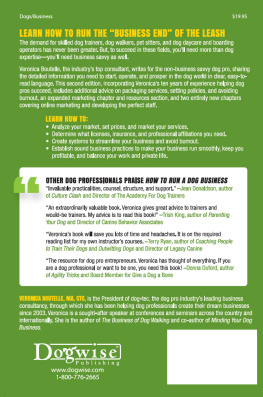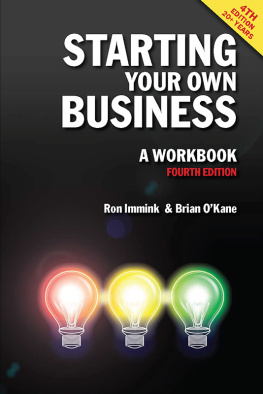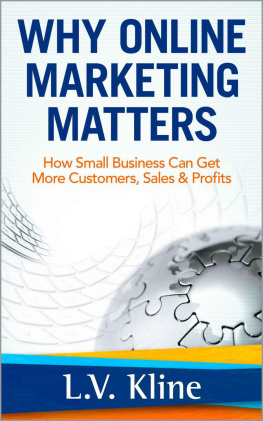How to Run a Dog Business
Putting Your Career Where Your Heart Is, 2nd Edition
Veronica Boutelle
Dogwise Publishing
A Division of Direct Book Service, Inc.
403 South Mission Street, Wenatchee, Washington 98801
1-509-663-9115, 1-800-776-2665
www.dogwisepublishing.com / info@dogwisepublishing.com
2008 Veronica Boutelle
2014 Veronica Boutelle
Cover Design: Dan Phairas, Bangarang Media www.bangarangmedia.com
Interior Design: Lindsay Peternell
All rights reserved. No part of this book may be reproduced or transmitted in any form or by any means, electronic, digital or mechanical, including photocopying, recording or by any information storage or retrieval system without permission in writing from the publisher.
Limits of Liability and Disclaimer of Warranty: The author and publisher shall not be liable in the event of incidental or consequential damages in connection with, or arising out of, the furnishing, performance, or use of the instructions and suggestions contained in this book.
Library of Congress Cataloging-in-Publication Data
Boutelle, Veronica, author.
How to run a dog business : putting your career where your heart is / Veronica Boutelle. 2nd edition.
pages cm
Includes index.
ISBN 978-1-61781-136-4
1. DogsTrainingVocational guidance. 2. Dog trainers. 3. Small businessManagement. 4. New business enterprisesManagement. I. Title.
SF431.B68 2013
636.70887dc23
2013043245
ISBN: 978-1-61781-136-4
Printed in the U.S.A.
Dedication
I dedicate this book to my clients. Your courageous decision to pursue your dream of working with dogs for a living is why I do what I do.
Acknowledgements

Thank you first to my editor, Rikke Jorgensen, for your tremendous improvements to this work, your straightforward advice, and your invaluable support. Thank you to my dog*tec partner in crime Gina Phairas for too much to mention here. Thank you to our amazing manager and director of ops and all things, Deborsha, for keeping us all afloat. And thank you to all the clients Ive had the pleasure to work with and learn from over the first ten years of our dog*tec adventure.
On a personal note, I thank my husband Patrick for making sure I remember to eatand that there is something to eatwhen Im writing. And I thank my dad Ken for supporting everything Ive ever chosen to do.
Table of Contents


Helping the Helper
As Director of the San Francisco SPCA Academy for Dog Trainers, I had the opportunity to see Veronica in action when she ran the behavior and training department at the SF-SPCA. She said that what she most liked about the dog training world was helping other trainers to do their jobs. She mused about doing exactly that full-time, and the result was dog*tec, her consulting and seminar business, and now this book, How to Run a Dog Business. Veronica loves and respects dog trainers and genuinely loves helping them. And, aside from the invaluable practicalities, counsel, structure, and support she provides, there is her real-time model of how to handle clients, in this case the client being the trainer: authentically, with respect, patience and empathy. Not to mention the model of finding the niche that you like and are good at. A common theme of hers is playing to strengths and using solid strategies to handle everything else.
There was a Monday some months ago when I awoke to 86 emails in my inbox, all but five of which fell into two categories: junk and HELP! The triage strategy I used to sort through the mayhem was pure Veronica. The fact that I had a triage strategy and that turning to it came immediately, without agony, was pure Veronica. I could almost hear her voice in my head: Well, of course you cant do all of them. So lets talk about how much time on a typical day you want to put into answering cold, pro-bono, distance consult requests. (They have a category!) Once we have that time, we can work backwards and prioritize. Then well think about how, on a particularly bad day, youll raise the bar and end up deleting or referring more. A plan. A conscious plan. No, wait, bettera system. First delete the junk, then delete or refer requests from people you dont know, leaving colleagues and former students. Then the bad day clause kicks in, so delete or refer anything less concise than a few lines, leaving a manageable handful. Divide these into the time available and, voila, a time allocation for each. Reply and then get on with the rest of the badtime-wise badday. With some actual energy.
I also often get flashes of Veronica when I am in the offices of mental health professionals (which I have been known to be seen in). Two instances spring to mind. In one, a psychologist sagely and simply observed that I had difficulty setting limits. There are options in the face of such observations. Theres the Teflon option, such as the dismissive duh or the thats just who I am or, Teflon with a side of solipsism, somebody has to(save the world, the world being, of course, the dogs, all of them). Theres the externalizing option, inevitably some variation on how do I get them to stop(inviting me, and only me apparently, to save the world, i.e., all the dogs). The best option is, of course, the Veronica Option: absorption and reflection. Lets think about this, shed say and then help you think about it, always in a useful, non-stewy way. Everyone should be so lucky as to have a Veronica Option when these mental forks in the road appear. I hope that readers of this book will choose absorbreflect a lot. Several times per page actually. If you do this, youll end up with a tidy stable of Veronica Options.
The second Veronica flash came about when my curiosity got the better of me and I one day asked a psychiatrist who seemed to genuinely enjoy and be engaged by what she was doing, how she could stand to be a repository for peoples angst and suffering all day long. She paused only briefly before saying, I like my patients. It probably shouldnt have, but it blindsided me. The same theme has been oft-mused by my friend and colleague, Janis Bradley, whose bare reply to students and fellow trainers, when they lament the difficulties inherent in counseling dog guardians is: you gotta find a way to like your clients. The clients being the humans, not the dogs. As Veronica so aptly points out in the book youre about to read, dog training pulls people who have great, great affinity for dogs. By happenstance, some may also have a liking of, gift for, or training in helping people. But too often, in the dog trainers drama, the client is the perpetrator, the dog the victim and the dog trainer the tormented superhero. Burn-out city, that plot is.
In helping professions, wherein this role is more frankly acknowledged than in dog training, helping the helper is a long-standing theme. Support and replenishment for those who deal with humans in need is also a hot topic in domestic situationscaring for elderly or ill parents, nurturing a special needs child, sticking by a spouse through thick and thin. It is gratifying indeed to see the complexity and helping aspects of dog training acknowledged, taken apart, and made manageable. It will pull good people into the field and retain many more who might have otherwise burned out. I can honestly think of no better way to save all the dogs.













